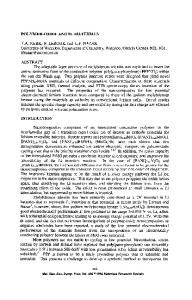Review of solid oxide fuel cell materials: cathode, anode, and electrolyte
- PDF / 1,164,486 Bytes
- 14 Pages / 595.276 x 790.866 pts Page_size
- 101 Downloads / 409 Views
REVIEW
Review of solid oxide fuel cell materials: cathode, anode, and electrolyte Saddam Hussain1 · Li Yangping1 Received: 18 August 2020 / Accepted: 29 September 2020 © The Author(s) 2020
Abstract There is a growing interest in solid oxide fuel cells (SOFCs) technology among the researchers a promising power generation with high energy efficiency, inflated fuel flexibility, and low environmental impact compared to conventional power generation systems. SOFCs are devices in which the chemical energy is directly converted into electrical energy with negligible emission. SOFCs have low pollution characteristics, high efficiency (~ 60%), and possess expanded fuel selection with little environmental effects. A single cell component of SOFCs is consisting an anode, cathode and an electrolyte which are stacked layer by layer to produce higher amount of power. The dense ceramic electrolyte transporting O2− ions and fills the space between the electrodes material. Redox reaction occurred at the electrodes side in the presence of fuels. The operating temperatures of SOFCs of 600–1200 °C which produced heat as a byproduct and fast electro-catalytic activity while using nonprecious metals. Many ceramic materials have been investigated for SOFCs electrolyte. Yttria-stabilized zirconia (YSZ) material was extensively used as dense electrolyte in SOFCs technology. In this review, the article presents; overview of the SOFCs devices and their related materials and mostly reviewed newly available reported. Keywords Solid electrolyte · Anode · Cathode · SOFC
Introduction Solid oxide fuel cell (SOFC) is the technologies which are gaining more attention in the modern era due to its optimal power generation boast with enough electrical efficiency for household devices and automobiles [1–11]. Fuel cell is an energy conversion electrochemical device, which provides enormous promise for delivering substantial environmental benefits and high electrical efficiency in terms of clean and efficient electric power generation [11–16]. Among the types of fuel cells, SOFCs offer diversified advantages such as fuel flexibility, desirable energy (chemical-to-electrical) conversion efficiency that unlimited by Carnot Cycle, chemically non-pollutant, lower emission of gases, generation of heat and electricity. It is considered that SOFCs are idealistic for future clean power generation. The technology of SOFC * Saddam Hussain [email protected] 1
State Key Laboratory of Solidification Processing, School of Materials Science and Engineering, Northwestern Polytechnical University, Xi’an 710072, Shaanxi, People’s Republic of China
is not limited of traditional heat engines, which admit the problems of leakage, lubrication, and heat loss [1, 17–19].
Structure and mechanism of solid oxide fuel cell A single fuel cell consists of a cathode and an anode separated by a solid oxide electrolyte as shown in Fig. 1 [1, 5, 10–19]. The fuel (hydrogen, methane, etc.) is continuously provided to the anode side and an oxidant continuously provi
Data Loading...











